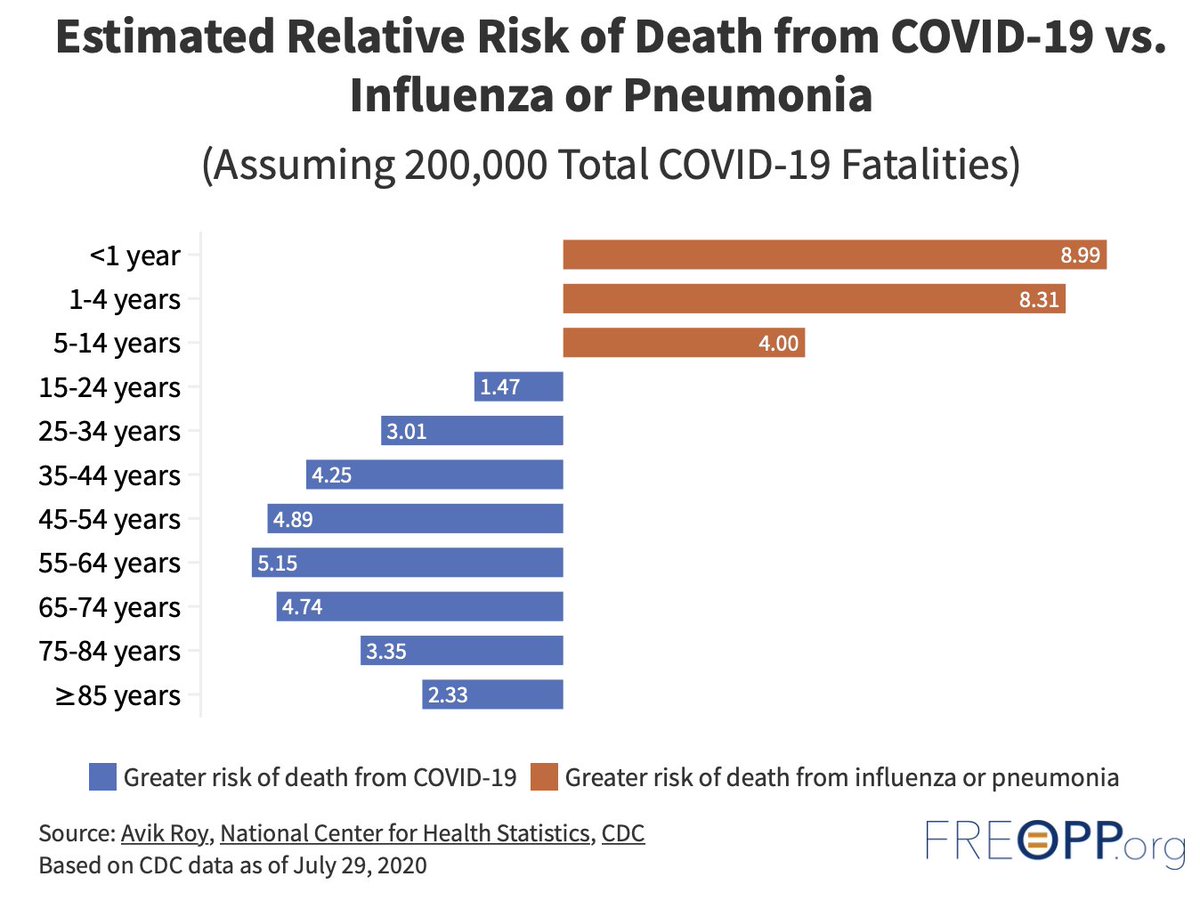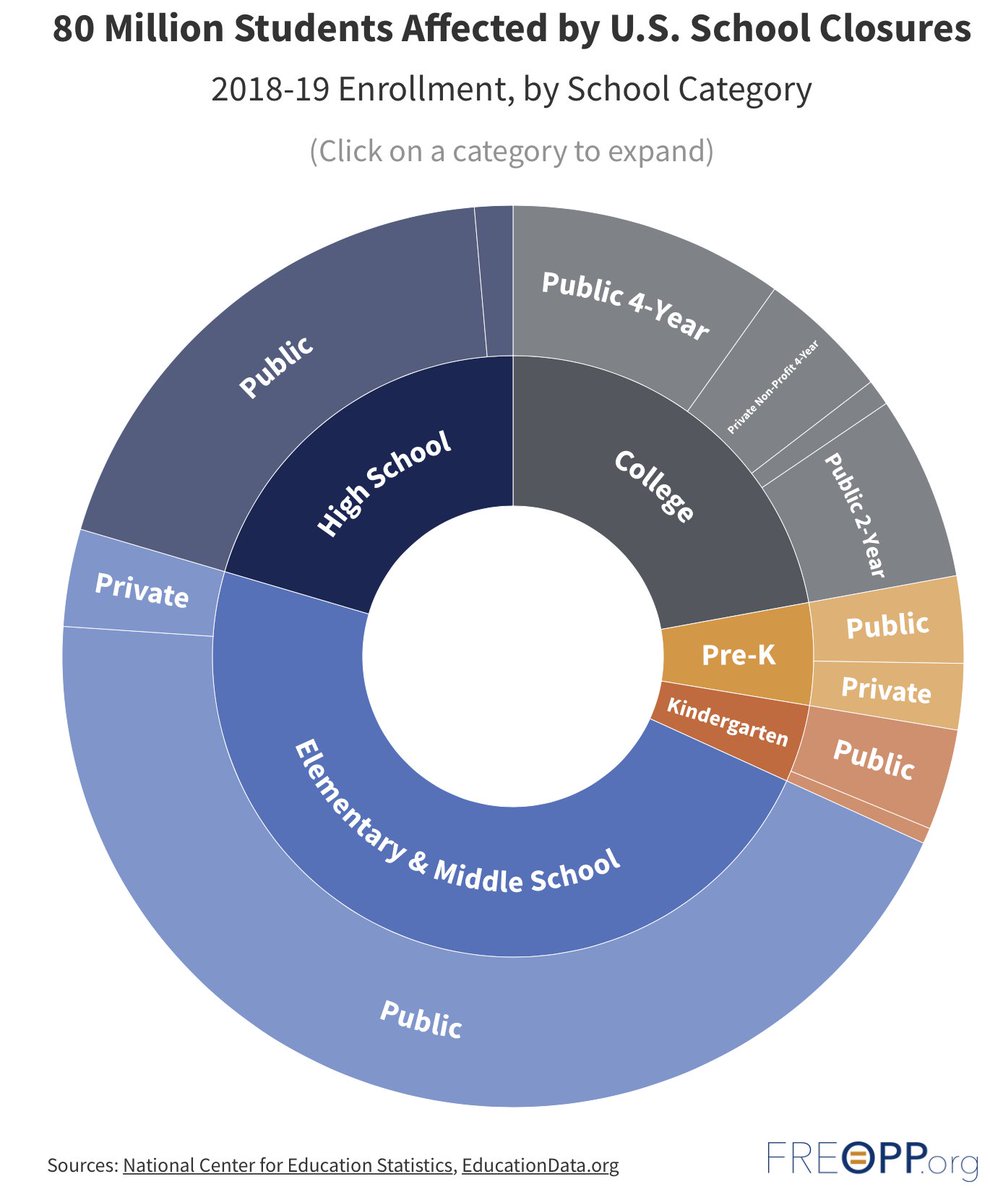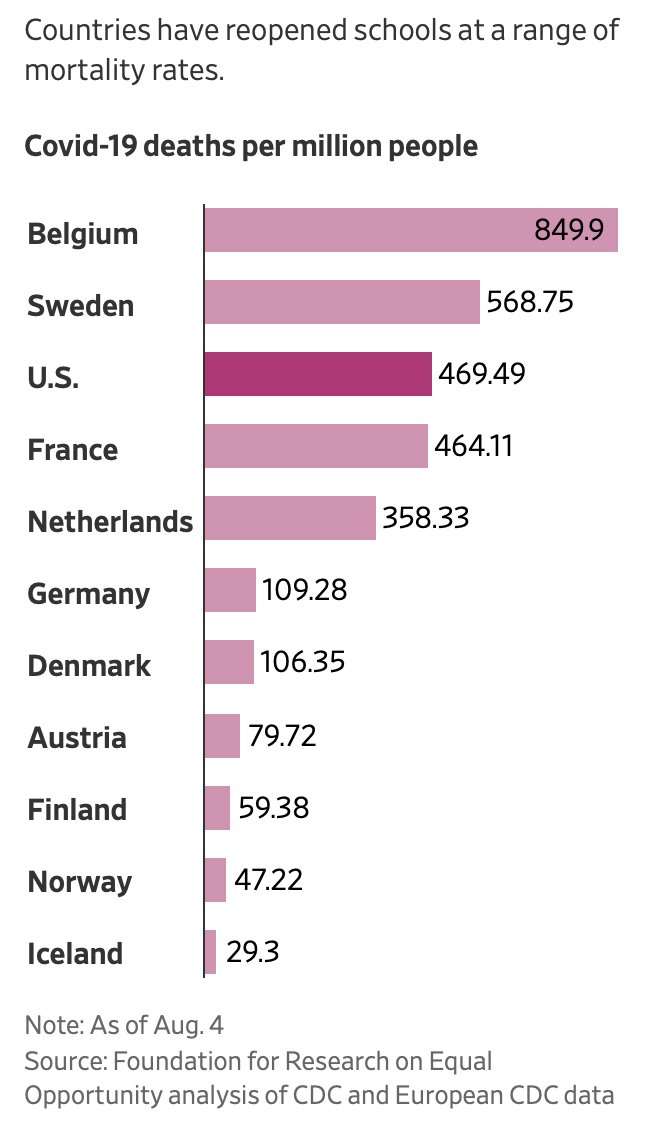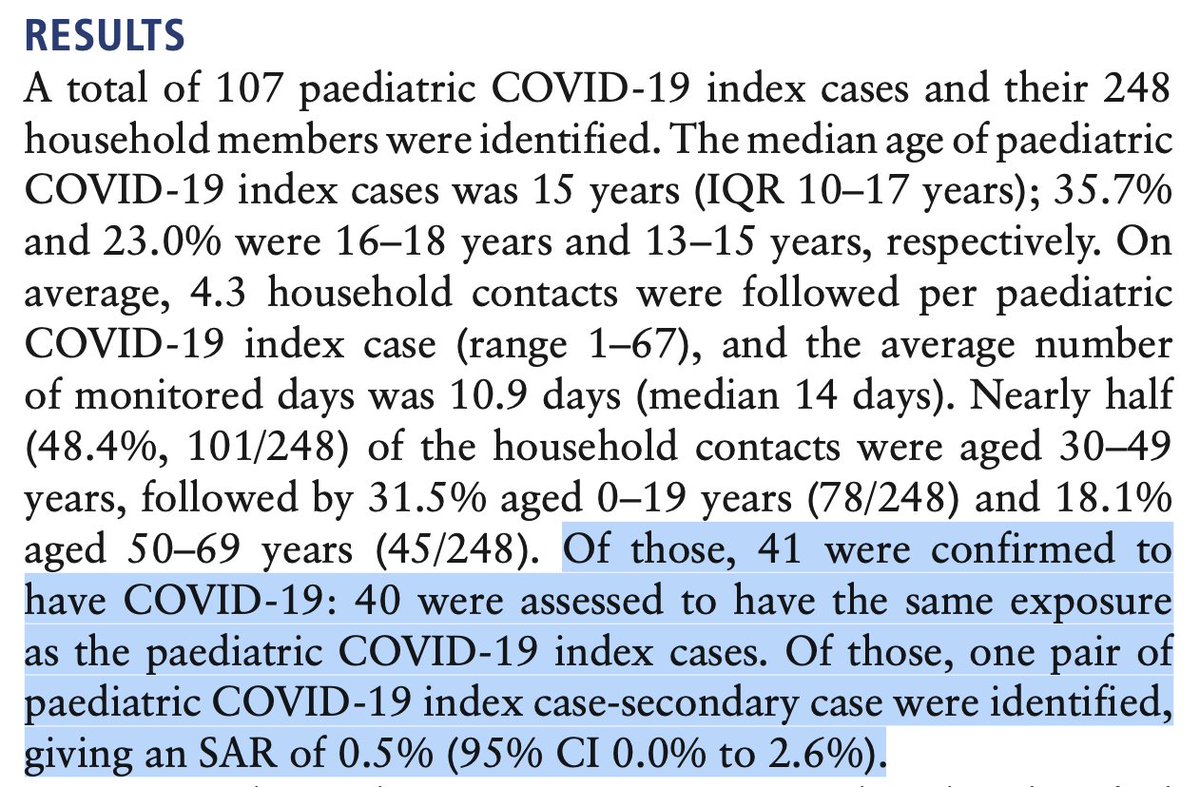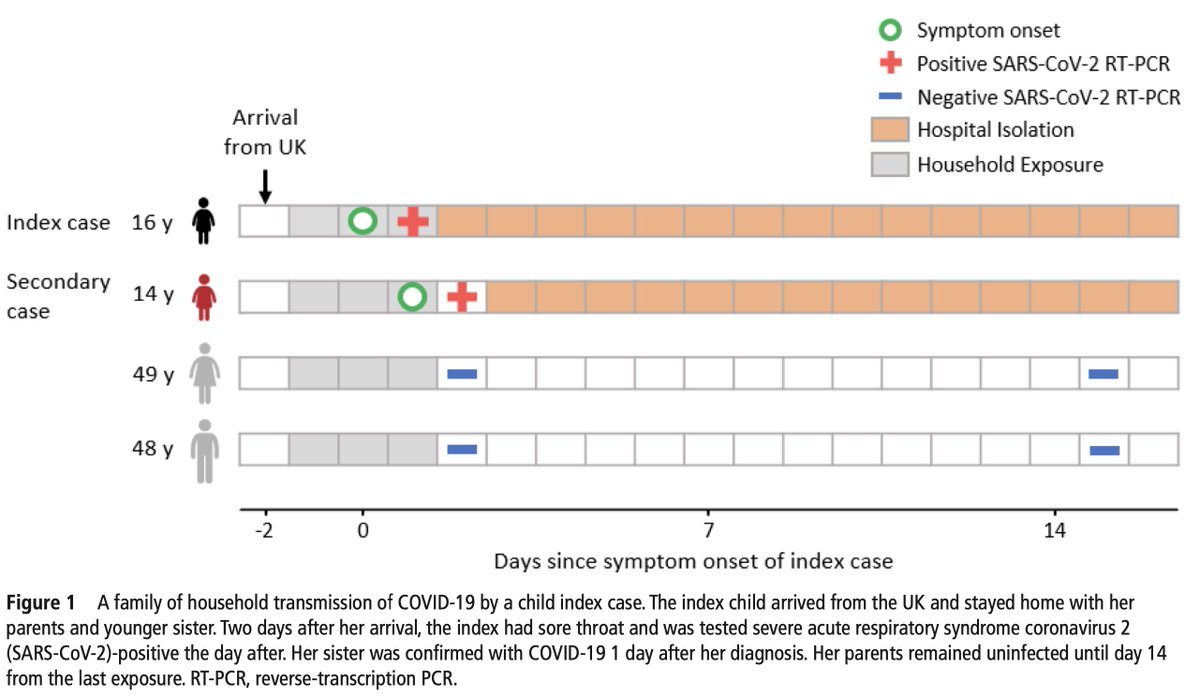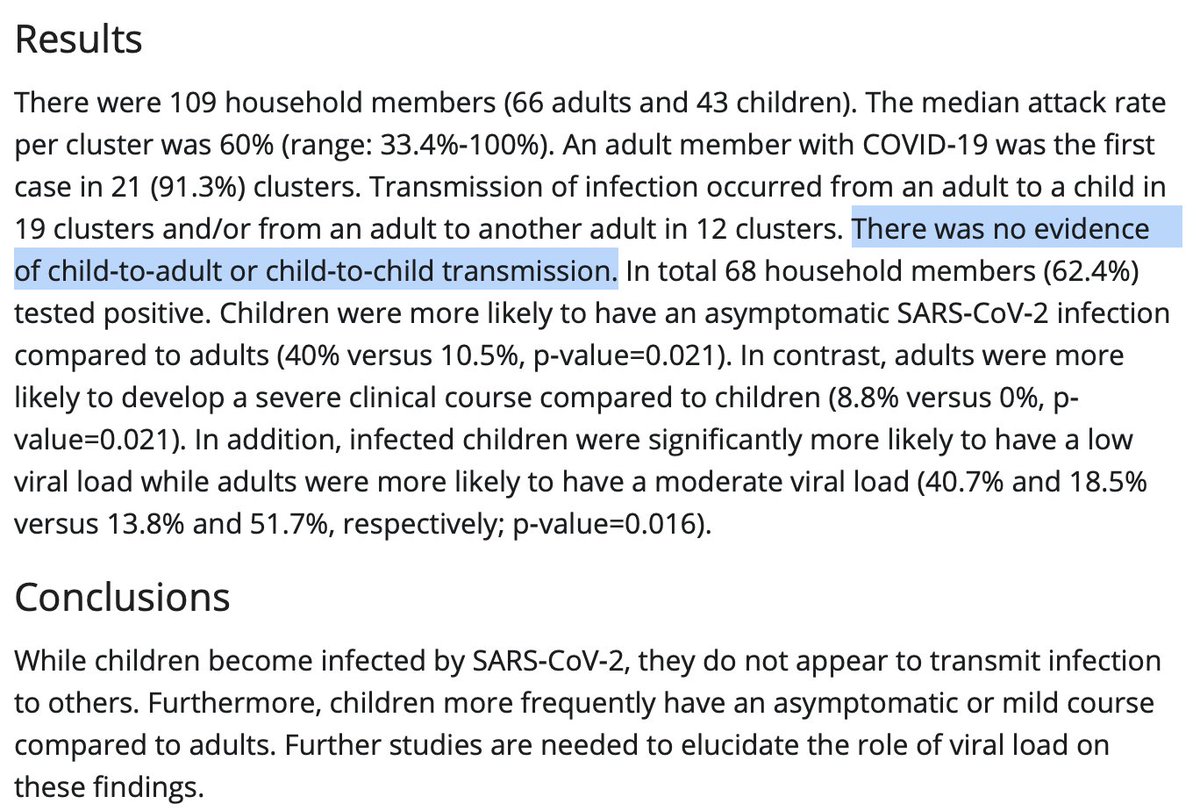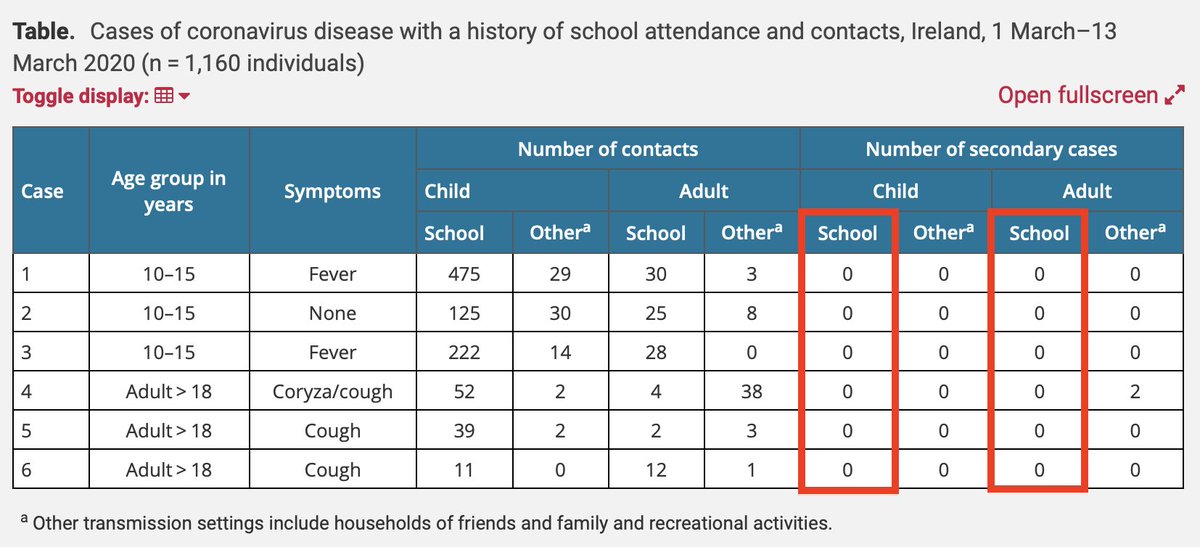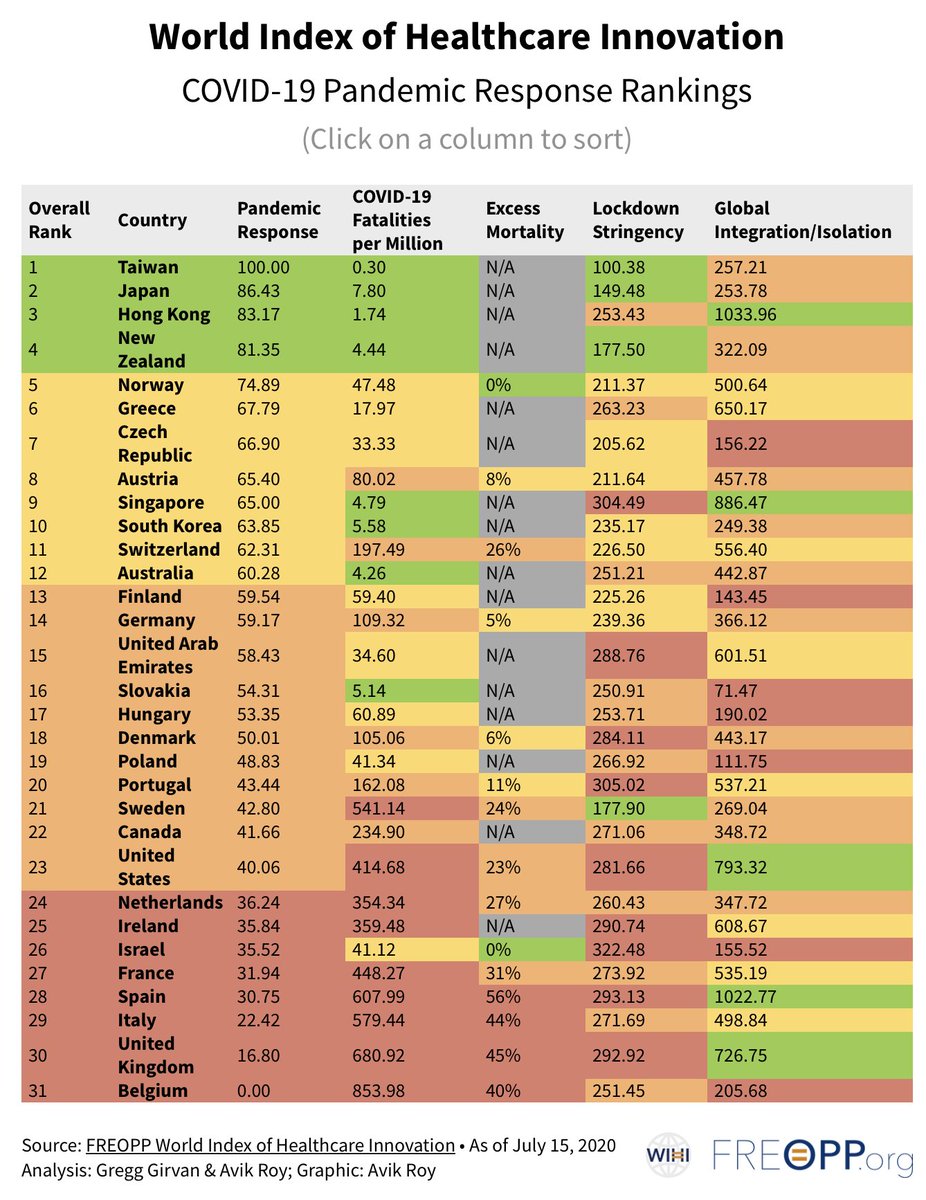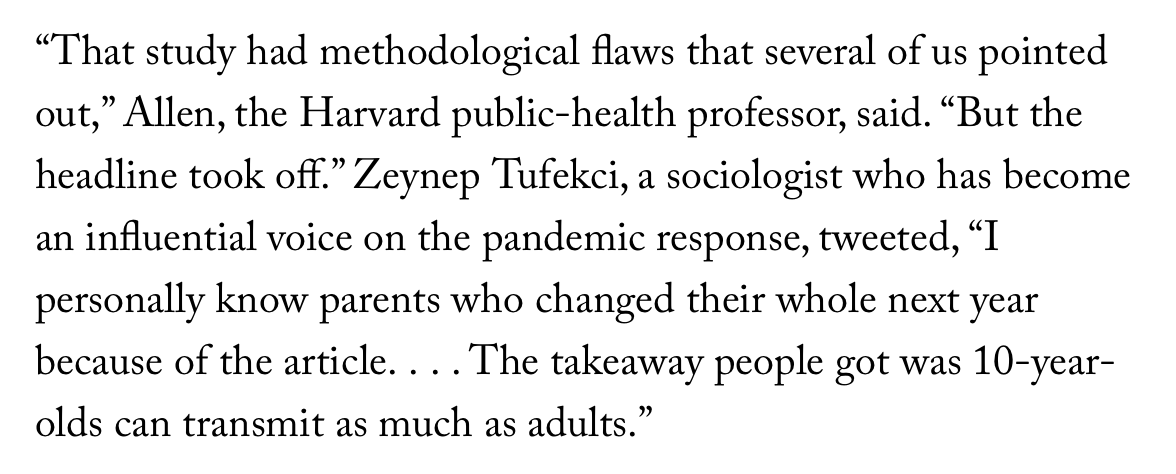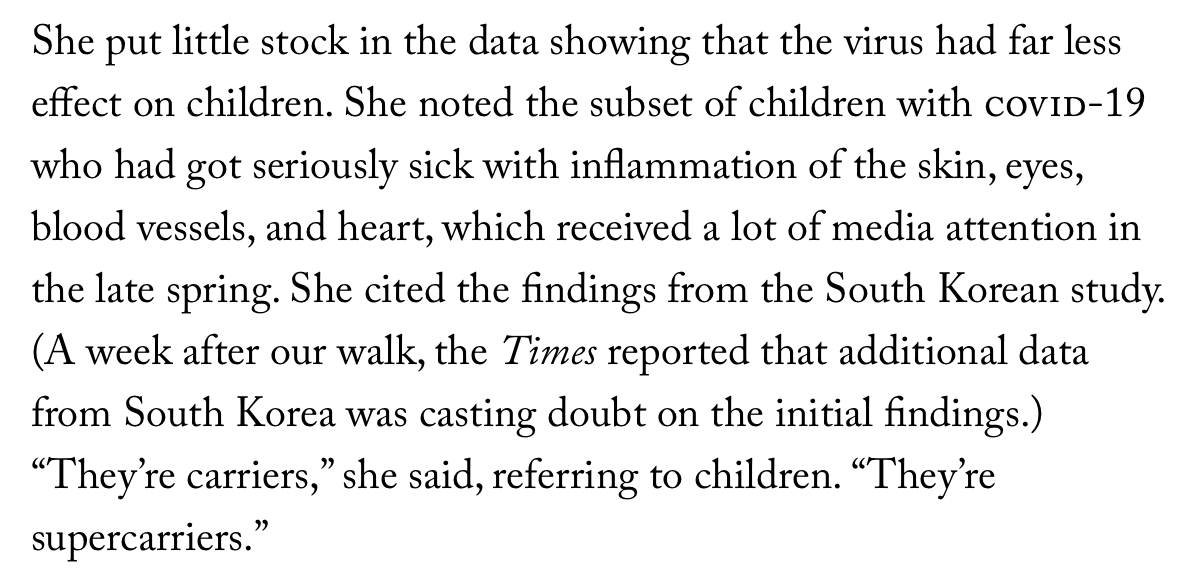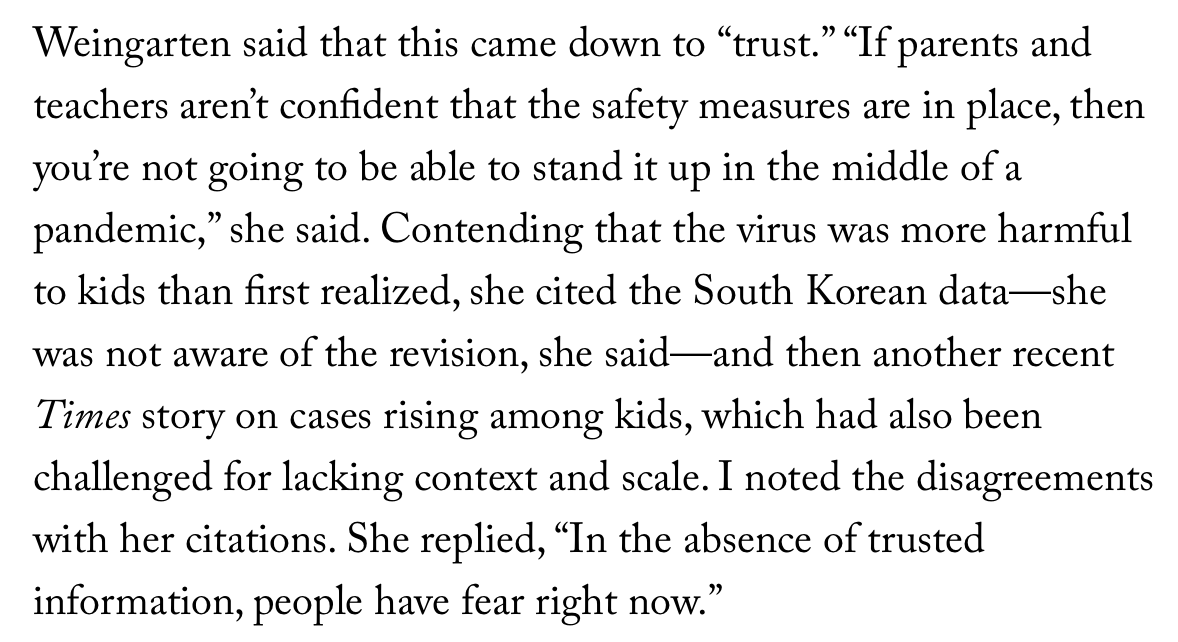New: my @WSJ Review cover story on the compelling case for reopening schools, especially for younger children. Children themselves are at extremely low risk of serious illness or death. So the question I answer is: can children pass #COVID19 to adults? https://www.wsj.com/articles/why-its-mostly-safe-to-reopen-the-schools-11596812466">https://www.wsj.com/articles/...
To repeat: we *know* that the risk of children dying of #COVID19 is comparable to, or much lower than, dying of influenza/pneumonia. We detail those figures @FREOPP: https://freopp.org/estimating-the-risk-of-death-from-covid-19-vs-influenza-or-pneumonia-by-age-630aea3ae5a9">https://freopp.org/estimatin...
There are 45 million U.S. children in pre-K, kindergarten, elementary, or middle school. Only 28 children aged 1-15 have died of #COVID19. Not 28 million—28. https://freopp.org/reopening-americas-schools-and-colleges-during-covid-19-bdb35e3e32c4">https://freopp.org/reopening...
Every death from #COVID19 is a tragedy. But that doesn& #39;t mean we should keep schools closed. In 2009-10, 317 U.S. children died in a major swine flu pandemic. We didn& #39;t close schools in 2009-10. https://academic.oup.com/cid/article/52/suppl_1/S69/499083">https://academic.oup.com/cid/artic...
Even if children themselves are mostly safe, what is the risk they could transmit the virus to adults? As I detail in the @WSJ article, there is little to no evidence of younger children transmitting SARS-CoV-2 to adults. Adolescents are a different story. https://www.wsj.com/articles/why-its-mostly-safe-to-reopen-the-schools-11596812466?fbclid=IwAR2m-OGYoUZkniG0yArCiWQtJHxBpOBmXxbOmKO5q1A4CU1aFN8lfaZpALA">https://www.wsj.com/articles/...
Now, let me go through the strongest piece of the case for reopening schools: the real-world experience of European countries. Denmark reopened on April 6, as #COVID19 cases crested. Danish Serum Institute epidemiologist concluded: "No negative effects." https://www.reuters.com/article/us-health-coronavirus-denmark-reopening/reopening-schools-in-denmark-did-not-worsen-outbreak-data-shows-idUSKBN2341N7">https://www.reuters.com/article/u...
Holland reopened w/o masking or distancing mandates. #COVID19 cases declined. Dutch National Institute for Public Health & Environment said results "confirm the impression that children do not play a significant role in the transmission of the virus." https://www.rivm.nl/en/news/initial-results-on-how-covid-19-spreads-within-dutch-families">https://www.rivm.nl/en/news/i...
@deCODEgenetics, an Icelandic biotech company, did a population-wide study after Iceland reopened schools, published in @NEJM. "We have not found a single instance of a child infecting parents," said Kári Stefánsson, CEO and leader of the research group. https://www.sciencemuseumgroup.org.uk/blog/hunting-down-covid-19/">https://www.sciencemuseumgroup.org.uk/blog/hunt...
Germany, unlike Holland, reopened schools cautiously & carefully in May, with half-sized classes, 1-way hallways, masks, etc. Researchers in Dresden concluded child infectivity had been "overestimated...schools did not become hotspots after reopening." https://www.theguardian.com/world/2020/jul/13/german-study-covid-19-infection-rate-schools-saxony">https://www.theguardian.com/world/202...
Indeed, some German researchers believe that "children may even act as a brake on infection." A Univ. of Münster study suggests that hospitalized patients in regular contact w/ children were much less likely to need to go to the ICU (16% vs. 40%; p=0.056). https://www.medrxiv.org/content/10.1101/2020.07.20.20157149v1">https://www.medrxiv.org/content/1...
France reopened schools in May, with mask requirements for high schoolers but not younger kids. A study by researchers at @institutpasteur of kids aged 6-11 concluded "there was no evidence of onwards transmission from children in the school setting." https://www.pasteur.fr/fr/file/35404/download">https://www.pasteur.fr/fr/file/3...
Notably, the study was conducted in Crépy-en-Valois, which had seen an outbreak originating from 2 high school teachers that spread to adolescent students. France’s success led the govt. to make school attendance *mandatory* for primary and middle schools. https://www.washingtonpost.com/world/europe/schools-reopening-coronavirus/2020/07/10/865fb3e6-c122-11ea-8908-68a2b9eae9e0_story.html">https://www.washingtonpost.com/world/eur...
Now Sweden & Finland. Sweden, of course, had a minimal lockdown, and never closed schools for under-16s. Finland followed the more conventional route. A study by Swedish & Finnish health authorities found *identical* infection rates in kids of 5/10,000. https://www.folkhalsomyndigheten.se/contentassets/c1b78bffbfde4a7899eb0d8ffdb57b09/covid-19-school-aged-children.pdf">https://www.folkhalsomyndigheten.se/contentas...
Surveying the broad experience in their countries, Sweden & Finland health authorities concluded that “Finland has not shown children to be contributing much in terms of transmission” to adults, and in Sweden there was “no increased risk for teachers.” https://www.wsj.com/articles/why-its-mostly-safe-to-reopen-the-schools-11596812466?fbclid=IwAR2m-OGYoUZkniG0yArCiWQtJHxBpOBmXxbOmKO5q1A4CU1aFN8lfaZpALA">https://www.wsj.com/articles/...
Contrary to what a lot of U.S. news consumers believe, the U.S. does *not* have a higher mortality rate from #COVID19 than every other country. Schools reopened in Belgium, Sweden, France, & Holland, all countries with comparable mortality to the U.S. https://freopp.org/measuring-covid-19-pandemic-response-world-index-of-healthcare-innovation-548664fca308">https://freopp.org/measuring...
For example, France& #39;s mortality from #COVID19 is almost identical to the U.S., and yet, as noted above, not only did they reopen schools but they made attendance mandatory.
Now the one caveat to all this good news (or, at least good news for people who are rooting for us to succeed) is that we do see examples of adolescents, especially high schoolers, serving as reservoirs of transmission to adults. So we will need to be more careful reopening HS.
Staggering high school classes, so that students go in part time on a rotated basis, will be necessary in places with large community outbreaks or outdated facilities with poor ventilation or cramped spaces. https://www.wsj.com/articles/why-its-mostly-safe-to-reopen-the-schools-11596812466?fbclid=IwAR2m-OGYoUZkniG0yArCiWQtJHxBpOBmXxbOmKO5q1A4CU1aFN8lfaZpALA">https://www.wsj.com/articles/...
This brings me to the most important policy idea from @DanLips in the @FREOPP school reopening white paper: microschools, or "pods." Parents with means are joining together to hire teachers to teach in parents& #39; homes. https://www.nytimes.com/2020/07/22/parenting/school-pods-coronavirus.html">https://www.nytimes.com/2020/07/2...
But why should microschools be only for the wealthy & upper middle class? Congress & states should convert government #COVID19 relief and other funds into Education Savings Accounts that low-income parents can use to microschool *their* kids. https://freopp.org/reopening-americas-schools-and-colleges-during-covid-19-bdb35e3e32c4">https://freopp.org/reopening...
Put another way: if teachers& #39; unions insist on keeping schools closed—whether you agree with them or not—parents should be able to receive those funds and use them to educate their kids in the manner of their choosing.
In the @WSJ article I published Saturday on reopening schools, I talk about a South Korean study that got top billing @nytimes with the headline "Older Children Spread the Coronavirus Just as Much as Adults, Large Study Finds." Well, now there& #39;s a twist. https://www.nytimes.com/2020/07/18/health/coronavirus-children-schools.html">https://www.nytimes.com/2020/07/1...
Researchers at the Korea CDC just published their updated findings at @BMJ_Latest. They looked at 107 pediatric index cases which were associated with 41 adult cases. But 40/41 were concurrent infections, meaning that only *one* child was ID& #39;d as having infected someone else.
The lone case of a South Korean child infecting someone was a 16 y/o who infected her 14 y/o sibling. "Their parents were not infected at day 14 from the last exposure to the secondary case." In other words, according to the Korea CDC, there were 0 cases of kids infecting adults.
The authors of the new study acknowledge limitations to their work (which also apply to the previous paper promoted by @nytimes). Schools were closed in South Korea. But as they note, closures "would likely increase [infectivity] among household contacts." https://adc.bmj.com/content/archdischild/early/2020/08/06/archdischild-2020-319910.full.pdf">https://adc.bmj.com/content/a...
Now, the question is: if it doesn& #39;t bleed, does it lead? Will @nytimes give this new paper the same prominent discussion that it gave the last one?
To revise one of the above tweets: the new Korean study looked at *all* secondary infections, including child-to-child, not just child-to-adult. In summary: while there remains reason for caution re infectivity of older children (but not younger children), Korea saw almost none.
As a point of comparison: in Sweden, schools were *never* closed for kids under 16, and there was wide spread of #COVID19 due to the country& #39;s minimal lockdown. Nonetheless, for kids under 19, "ICU admittance is very rare...and no deaths were reported." https://www.folkhalsomyndigheten.se/contentassets/c1b78bffbfde4a7899eb0d8ffdb57b09/covid-19-school-aged-children.pdf">https://www.folkhalsomyndigheten.se/contentas...
A new study of 23 family clusters in Greece finds "there was no evidence of child‐to‐adult or child‐to‐child transmission." (h/t @marsilcos) https://onlinelibrary.wiley.com/doi/abs/10.1002/jmv.26394">https://onlinelibrary.wiley.com/doi/abs/1...
A May 2020 study in Ireland looked at every positive case of #COVID19 with a history of school attendance. There were 6 such cases in the entire country, of which 0 involved transmission within a school. (h/t @marsilcos) #html_fulltext">https://www.eurosurveillance.org/content/10.2807/1560-7917.ES.2020.25.21.2000903 #html_fulltext">https://www.eurosurveillance.org/content/1...
Notably, Ireland has been hard hit overall by #COVID19 (359 deaths per million). https://freopp.org/measuring-covid-19-pandemic-response-world-index-of-healthcare-innovation-548664fca308">https://freopp.org/measuring...
The @nytimes says it& #39;s a "scandal" that the Trump administration tried to get the CDC to accurately describe the risk/reward of opening schools. The real scandal is that the NYT—and CDC bureaucrats—disregard the data showing that reopening is good policy. https://www.nytimes.com/2020/09/28/us/politics/white-house-cdc-coronavirus-schools.html?smid=tw-nytimes&smtyp=cur">https://www.nytimes.com/2020/09/2...
In the above article, @nytimes reporters claim that "a large study from South Korea" showed kids 10-19 "can spread the virus as much as adults do." That conclusion was debunked by *the Korean CDC* on August 8. The @nytimes article was published on Sep 28. https://twitter.com/Avik/status/1292923082248773634">https://twitter.com/Avik/stat...
The irresponsible and anti-scientific reporting about South Korean #COVID19 data by @nytimes is the real scandal, as @AlecMacGillis describes powerfully in this @NewYorker essay, because it scared teachers & parents into forcing kids out of school. https://www.newyorker.com/magazine/2020/10/05/the-students-left-behind-by-remote-learning">https://www.newyorker.com/magazine/...
"I personally know parents who changed their whole next year because of the article," one influential sociologist told MacGillis. A 4th-grade teacher in Baltimore, and teachers& #39; union boss @rweingarten cited the @nytimes article on South Korea as the reason to keep kids home.

 Read on Twitter
Read on Twitter